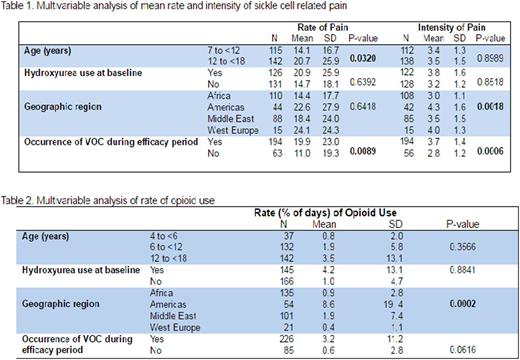Abstract
Background: Determining Effects of Platelet Inhibition on Vaso-Occlusive Events (DOVE) was a multi-national Phase 3 trial to assess the efficacy of prasugrel for the prevention of vaso-occlusive crisis (VOC) as a composite endpoint of painful crisis or acute chest syndrome in children and adolescents aged 2-18 years with sickle cell anemia (SCA). Despite a trend toward fewer VOCs in the prasugrel-treated oldest age group (12-18 years), DOVE did not meet its primary endpoint. This was the first multinational prospective study of diary-reported pain rate and intensity in children and adolescents with SCA.
Aim of current study: This sub-study evaluated VOC events (as defined by DOVE), analgesic use, and the rate, intensity, and perception of pain by geographical region and age group.
Data: During the DOVE study, participants who were 4 years or older used daily diaries to report pain rate and intensity, and analgesic use. Rates of pain and analgesic use were calculated for each patient by summing the number of days with any pain or analgesic use reported divided by the number of non-missing diary entries from randomization to 9 months. Mean pain intensity was calculated similarly, but days in which participants reported pain of "0" were not included. Pain rate and intensity were evaluated only for participants 7 years or older. Type of analgesic use (opioid vs non-opioid) was also evaluated in all participants. Treatment arms (prasugrel-treated and untreated patients) were combined for the current analysis, as justified by the lack of a statistically significant treatment effect. Data were analyzed by univariable and multivariable methods.
Results: There was no association between baseline hematology labs or lactic dehydrogenase levels and pain rate or intensity. In multivariable analysis, older participants (aged ≥12 years) reported more frequent pain than younger participants (p=0.0320). Hydroxyurea (HU) use at baseline did not affect pain rate or pain intensity. The regions of the Americas and West Europe showed higher pain rate and intensity scores than Africa and the Middle East. (Table 1) Opioid use was much higher in the Americas compared with other regions p=0.0002. (Table 2)
Conclusions: Pain rates were higher in older children, demonstrating a worsening of pain during the lifespan, which is consistent with previous literature. Pain rate and intensity were similar irrespective of HU treatment; whether this finding reflects increased baseline pain in participants on HU or other causality is unclear. Regional differences in pain rate and intensity were seen. Pain intensity and opioid use were significantly higher in the Americas than in other regions. In contrast, the lowest reported pain rates and intensities were found in Africa. These findings suggest cultural and/or regional differences in SCA pain perception and reporting that require further exploration. The relationship between pain intensity and analgesic treatment practices also needs further study.
Kanter:Novartis: Consultancy. Heath:Eli Lilly and Company: Employment. Zhou:Eli Lilly and Company: Employment, Other: Minor Shareholder. Colombatti:Eli Lilly and Company: Research Funding. Dampier:Eli Lilly and Company: Consultancy, Research Funding. Hassab:Eli Lilly and Company: Research Funding. Brown:Eli Lilly and Company: Employment, Other: Minor Shareholder. Jakubowski:Eli Lilly and Company: Employment, Equity Ownership. Yao:Eli Lilly and Company: Employment. Knorr:Eli Lilly and Company: Employment, Equity Ownership. Hoppe:Eli Lilly and Company: Consultancy.
Author notes
Asterisk with author names denotes non-ASH members.


This feature is available to Subscribers Only
Sign In or Create an Account Close Modal